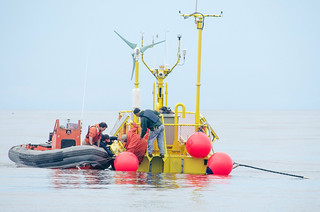(This post was co-written by Kelsey Adkisson, Oregon Sea Grant Marine Policy Fellow and Ivan Kuletz, Oregon Sea Grant Marine Policy Intern. )
Oregon doesn’t stop at the beach. In fact, the shoreline is just the beginning of an incredibly complex and thriving marine environment full of colorful rockfish, towering kelp forests, expansive sandy flats, jagged rocky reefs, and a diversity of unique invertebrates.
 To ensure this environment remains healthy and vibrant, the Oregon Department of Fish and Wildlife (ODFW) and Oregon Sea Grant (OSG) teamed up and developed a successful partnership that focuses on enhancing the intersection of science and management. This partnership has fostered fellowships and scholarships that support science-based resource management issues. As part of this collaboration, two OSG Fellows, Kelsey Adkisson and Ivan Kuletz, worked with ODFW on a great example of Oregon’s support for science-based ocean resource management- the Oregon Nearshore Strategy.
To ensure this environment remains healthy and vibrant, the Oregon Department of Fish and Wildlife (ODFW) and Oregon Sea Grant (OSG) teamed up and developed a successful partnership that focuses on enhancing the intersection of science and management. This partnership has fostered fellowships and scholarships that support science-based resource management issues. As part of this collaboration, two OSG Fellows, Kelsey Adkisson and Ivan Kuletz, worked with ODFW on a great example of Oregon’s support for science-based ocean resource management- the Oregon Nearshore Strategy.
The Oregon Nearshore Strategy is a set of prioritized recommendations for conservation, management, and research of species and habitats that occur within state waters. Oregon’s nearshore environment is home to a vast array of species and habitats. All of which are integral components of a complex nearshore ecosystem. This ecosystem is interconnected through food webs, ocean currents, and a multitude of other biological, physical, chemical, geological and human use factors.
 Originally developed in 2005, and currently undergoing a ten year revision, the Nearshore Strategy was created via a collaborative process led by ODFW. Members of the public, ocean-related businesses, recreational interests, conservation groups, government agencies, tribes, universities, and many other sectors helped contribute to the Strategy.
Originally developed in 2005, and currently undergoing a ten year revision, the Nearshore Strategy was created via a collaborative process led by ODFW. Members of the public, ocean-related businesses, recreational interests, conservation groups, government agencies, tribes, universities, and many other sectors helped contribute to the Strategy.
“At its core, the Nearshore Strategy is intended to contribute to the larger domain of marine resources management and focus actions towards priority issues and areas that have not already received the attention they deserve,” explained Caren Braby, the ODFW Marine Resources Program Manager. “Ultimately, the Strategy’s effectiveness hinges on public input, which helps shape the document, and also ensures that diverse perspectives, values, visions and concerns for the nearshore environment are represented.”
As part of the 2015 revision process, Kelsey and Ivan worked with ODFW Project Leader, Greg Krutzikowsky, to review and update the enormous body of scientific knowledge that underpins the document. This information was used to develop recommendations that support Oregon’s diversity of marine life. As Sea Grant Scholars, it was a unique experience to be part of something that is used by such a broad variety of interest groups, including federal agencies, policy makers, citizen groups, fishermen, conservation organizations, and researchers.
The Nearshore Strategy is currently undergoing public review and the update is due to be completed by October 1, 2015. Public input is essential to shaping and prioritizing resource needs for the next ten years and ODFW is seeking input on the Strategy. To review the Oregon Nearshore Strategy, provide input, or find out more about the revision process please visit the ODFW Oregon Nearshore Strategy website: (http://www.dfw.state.or.us/MRP/nearshore/index.asp).
Learn more:
(Photo credits: Janna Nichols)













